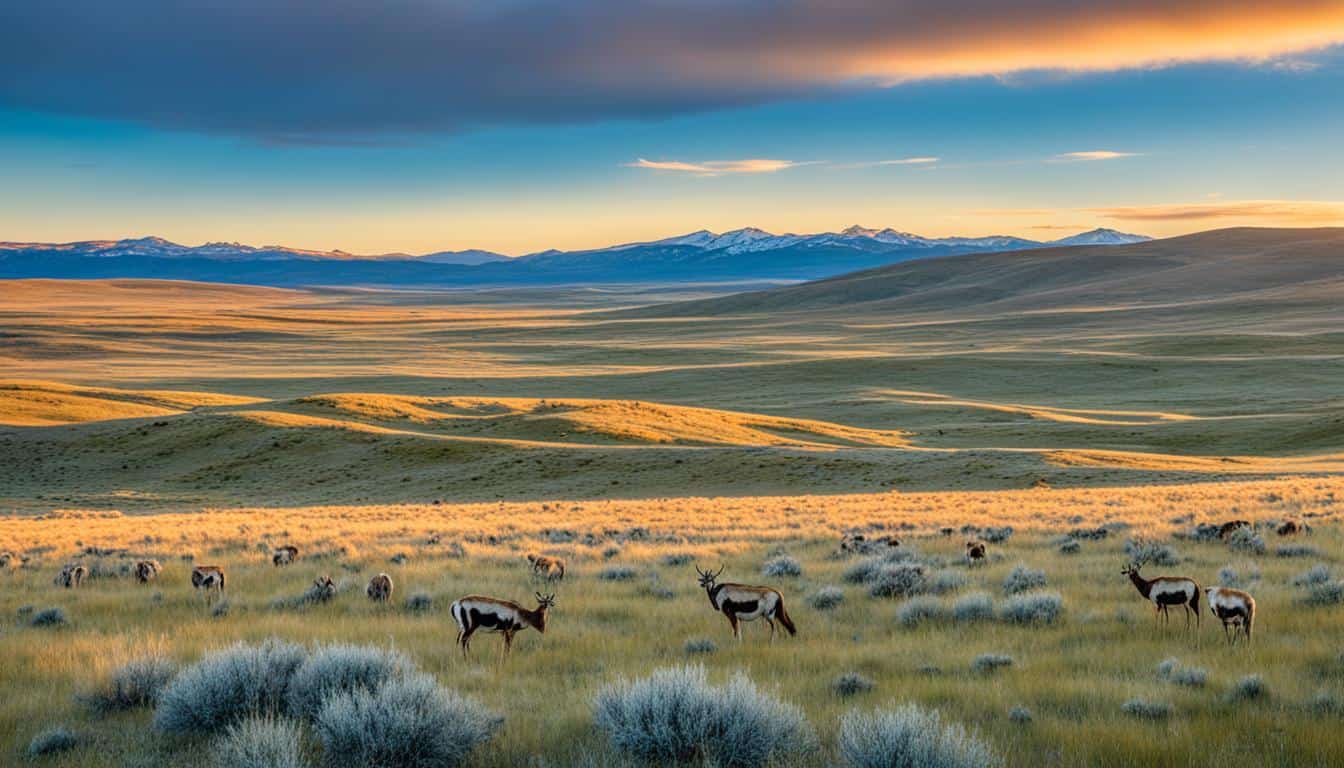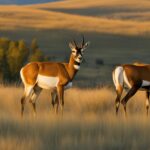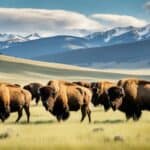Pronghorn antelope live mainly in Yellowstone National Park. They are most visible in the Lamar Valley and near Gardiner, Montana’s North Entrance during summer. In the colder months, they move to places like the North Entrance and Reese Creek. They got their name because they look a bit like African antelopes, but they are unique to the Americas.
This animal’s history in North America stretches back 20 million years. It can run as fast as 45 to 50 miles per hour to escape danger. Once, there were millions of them, but that number dropped because of land changes and hunting. Today, with help from conservation, there are about half a million alive.
Before, pronghorn antelope lived all across the central and western U.S. Now, you mostly see them in special areas and on grasslands. Watching them in their natural home shows their strong survival skills and their incredible speed.
Introduction to Pronghorn Antelope
The pronghorn antelope looks a bit like an antelope but isn’t one. It’s unique, belonging to a different family. This makes it special in the animal kingdom.
This animal is unique. It’s not just related to antelopes. Its family also includes giraffes and okapis. Despite their familiar look, pronghorn are much faster, thanks to their evolutionary past.
Pronghorn antelope can be seen across the USA’s center and west. Their speed helps them escape danger, but they’re also tough in different climates. This mix of skills sets them apart.
Studying pronghorn teaches us a lot about nature. It shows us how they fit into the wild world. This knowledge helps us protect these beautiful animals better.
| Characteristic | Detail |
|---|---|
| Speed | Up to 55 mph |
| Closest Relatives | Giraffe, Okapi |
| Native Range | Western and Central USA |
| Family | Antilocapridae |
| Predators | Extinct, including American Cheetah |
Pronghorn Antelope Habitat
Pronghorn antelopes are known for their incredible speed and strength. They live in special places that meet their needs. Harsh environments often make seeing pronghorn antelope very special.
Grasslands and Shrublands
These tough animals like open spaces such as grasslands and shrublands. You can usually find them between 900 to 1,800 meters above sea level. They do well in areas with 250 to 400 mm of rain every year.
Pronghorns can eat many kinds of plants. This includes plants that are not safe for farm animals. This shows how adaptable they are to their environments.
Migration and Seasonal Variation
Pronghorn antelope move a lot to find food and stay healthy. They travel to find new food all year round. This moving between their winter and summer homes is essential to their survival.
It allows them to always find the best food and keeps their numbers strong. Seasonal movement is key to their well-being.
Pronghorns live in parts of the USA, from Canada in the north to Mexico in the south. Places such as Arizona, Colorado, Idaho, and Montana are great for seeing them. Studying how they live and move helps protect these amazing animals.
| State | Elevation Range (meters) | Annual Precipitation (mm) |
|---|---|---|
| Arizona | 900-1,800 | 250-400 |
| Colorado | 900-1,800 | 250-400 |
| Idaho | 900-1,800 | 250-400 |
| Montana | 900-1,800 | 250-400 |
The Best Places to See Pronghorn Antelope
Pronghorn antelope are amazing creatures. The United States has many great spots for seeing them in the wild.
Yellowstone National Park
Yellowstone National Park is one of the best places to see pronghorn antelope. In the summer, you can often find them in the Lamar Valley. The Yellowstone National Park pronghorn group has grown since the 2000s.
Oregon
Oregon is perfect for pronghorn antelope watching too. They’ve made changes to fences for the antelope’s benefit. This makes it much easier and safer to see them in Oregon.
Wyoming
Wyoming is known for lots of wildlife, including pronghorn antelope. They are good at moving around and are seen everywhere. This is why you might see them if you visit Wyoming.
Pronghorn Antelope Range in the USA
The pronghorn antelope is from North America’s prairies. It mainly lives in the central and western USA. Before, they lived in a huge area of the Great Plains.
Central and Western USA
Nebraska, South Dakota, and Texas are main areas for pronghorn antelopes. They show they can live in many different places. This shows how adaptable they are.
Conservation work is crucial for their well-being. Through proper land use, these states protect the places the antelopes need. This makes it possible for them to grow in number.
| State | Conservation Efforts | Population Trends |
|---|---|---|
| Nebraska | Habitat Restoration, Predation Control | Stable |
| South Dakota | Land Management, Fencing Adjustments | Increasing |
| Texas | Protected Areas, Resource Management | Stable |
Because these antelopes can live in many areas, they have a better chance of surviving. It shows why we must protect their homes in the central and western USA.
Where can you find pronghorn antelope in the USA?
Pronghorn antelopes once roamed from Canada to Mexico across North America. But, human activities and changes to the land now limit where they can live. Today, you can find these amazing animals mainly in national parks and special grasslands.
Historical Range Compared to Modern Range
In the past, pronghorn antelopes lived in vast areas all over North America. But hunting and changes to their habitat have greatly reduced where they can be found. Now, they are mostly in the central and western parts of the USA.
Thanks to conservation efforts, their numbers are slowly growing in these smaller areas.
| Time Period | Range |
|---|---|
| Historic (Pre-1800s) | Canada to Mexico |
| Modern (2000s-Present) | Central and Western USA |
Their wide historical range shows they can live in many places. But, by focusing on conservation, they have a chance to flourish in specific areas today. This success is a great example of how nature can recover with our help.
Behavior and Adaptations of Pronghorn Antelope
Pronghorn antelope have amazing ways to survive in their world. They are really fast, which keeps them safe from predators. Their high speed comes from thousands of years of getting better, through evolution.
Speed and Evasion
Pronghorn antelope can run really fast. They reach speeds up to 55 mph to avoid being caught by predators. Their bodies are specially designed for this. A big windpipe and heart help them breathe and pump blood fast during a race. They also have special hoof glands that give them a good grip on the ground.

Horn Characteristics
Pronghorn antelope have unique horns that keep growing. Males have pronged horns that they lose and grow back each year. This helps during the mating season. They use their horns to show they are strong and to catch the eye of a female. They also defend their areas against other males with these horns.
Conservation Status and Threats
The pronghorn antelope once faced a huge population drop. This was due to too much hunting and loss of habitat in the American West. By the time this period ended, their numbers had dropped dangerously low.
Since then, people have been working hard to help them survive. The antelope are now listed as a species in need of special care.
Historical Population Decline
These antelopes used to be as common as bison. But overhunting and changes to their homes almost wiped them out. By the early 1900s, they almost disappeared completely in some areas.
Current Conservation Efforts
Today, things are looking up thanks to focused conservation work. By protecting their habitats and making fences easier to pass through, the antelopes are doing better. Yellowstone National Park has played a big role in this success.
| Conservation Effort | Impact |
|---|---|
| Habitat Management | Enhanced population recovery |
| National Park Protection | Safe haven for survival |
| Fence Modification | Facilitated migration |
But challenges still exist. Diseases can affect them, and they need to compete for resources with other animals. Their homes also keep getting smaller.
Pronghorn Migration Patterns
Pronghorn migration is an amazing natural event in the American grasslands. These wonderful animals travel long distances for the right places to live. It’s key they keep using these routes to survive well and keep their species healthy.
Migratory Routes
The routes these pronghorn follow are very important. They connect places the pronghorn need at different times of the year. With these paths, they can find food and shelter. But, things like roads and fences can get in their way. Luckily, people are working to help them.
Impact on Population Distribution
Their journeys help pronghorns live in many places. This diverse living space is good for their health and genes. However, human activities like building on land can harm them. Monitoring and helping these animals move is key to keep them safe. They play a vital part in the grasslands’ cycle.
FAQ
Where can you find pronghorn antelope in the USA?
You can spot pronghorn antelope across the central to western USA. Look in Yellowstone National Park, parts of Oregon, and Wyoming. They love open grasslands and shrublands.
What is the pronghorn antelope’s natural habitat?
They like open areas such as grasslands and shrublands. Their ideal spots sit between 900 to 1,800 meters high. These places get about 250–400 mm of rain a year.
What are the best places to see pronghorn antelope?
To catch a sight, visit Yellowstone National Park, Oregon, and Wyoming. In Yellowstone’s Lamar Valley, you’ll see more of them, especially in the summer.
How fast can pronghorn antelopes run?
They’re the fastest in the Western Hemisphere, hitting 55 mph. They can keep up 45–50 mph for a while.
What historical range did pronghorn antelope inhabit?
Their home used to stretch from southern Canada to Mexico in the central and western USA. Changes in the land and human actions have shrunk where they live now.
How have pronghorn antelope populations recovered?
Thanks to work in managing their habitat, guarding them in national parks, and making fences that help them move, their numbers are up.
What are the adaptations of pronghorn antelope?
They’re known for being quick and good at escaping. They have a big windpipe, heart, and special glands in their hooves. All these help with running and endurance.
What are the current threats to pronghorn antelope?
They face diseases, competition with other animals, and split-up living spots. People building roads and fences also make it hard for them.
How does pronghorn migration impact their population distribution?
Moving around is key for their health and making sure they mix genes. These travels help them find food in many places, affecting where they live and how many survive.







